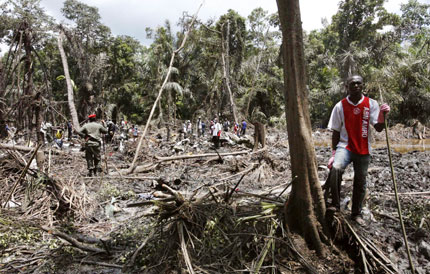MBANGA PONGO -- Rescue workers in Cameroon pulled remains of victims
from a fetid swamp on Monday two days after a Kenya Airways plane crashed,
killing all 114 people on board.

|
A
clean-up crew gathers at the scene of a Kenya Airways plane crash in a
swampy area close to the village of Mbanga Pongo, 23 km (14 miles) east of
the city of Douala, May 7, 2007.[Reuters]
| 
The Boeing 737-800 fell into densely forested swampland early on Saturday,
minutes after leaving Douala for Nairobi in torrential rain. Rescuers said they
had found one of two "black box" recorders which may shed light on the cause of
the crash.
"It's devastating. I found one or two whole bodies at the
start, but since then everything is in pieces," said Captain Francis Ekosso of
Cameroon's fire department, who was in charge of the rescue operation.
"People were afraid of the bodies at the start, so I had to pick them up
with my own hands, and they came apart in my fingers," he said.
The
plane was found late on Sunday in a mangrove swamp near Mbanga Pongo, around 20
km (12 miles) from Douala airport.
In a round crater gouged out of the
bush, victims' remains lay amid clothes, personal belongings and plane debris in
a hole filled with muddy water smelling of jet fuel and decomposition.
Rescue workers used a mobile generator to pump away water to expose more
of the wreckage, and retrieved one of the plane's black box recorders, said
Celeste Mandeng, of Cameroon's Civil Protection Service.
He was unable
to specify whether it was the flight data recorder or the cockpit voice register
which had been recovered.
Apart from the plane's nose jammed into the
mud, there was little left of the rest of the aircraft except fragments little
bigger than a car door.
Rescue workers had to hack through dense
mangrove and forest to reach the wreckage as helicopters and planes buzzed
overhead.
They then returned the several kilometres to the nearest road
carrying stretchers bearing victims' remains wrapped in white plastic.
Kamal Shah, a 32-year-old Kenyan who flew out from Nairobi after the
crash, searched through the wreckage in silence for any signs of his wife, Meera
Shah, 30. She had been on her way home from a short business trip, he said.
Initial Search Off Course
The wreckage was
located after nearly two days of fruitless searches well over 100 km (60 miles)
away in southern Cameroon, where radar-equipped helicopters and villagers on
motorbikes spent most of the weekend combing tropical forest.
Mandeng
said early search efforts had mistakenly focused on an area much further south
based on information received from a satellite tracking centre in Spain.
"The experts will check what has happened," he said.
The crash
has again thrown the spotlight on air safety in Africa, the continent with the
world's worst record.
It dealt a severe blow to the image of Kenya
Airways, one of the most successful and modern companies in the east African
nation. The airline is listed on three East African bourses and is 26 percent
owned by Air France's Dutch arm KLM.
The six-month-old aircraft was
carrying 105 passengers and nine crew from 27 nations, mostly African, with
others from China, India, Europe and elsewhere.
As soon as the plane
disappeared, questions were asked about why a jet less than a year old would
have crashed.
The flight
had originated in Ivory Coast, where a Kenya Airways Airbus A-310 plunged into
the sea moments after takeoff in January 2000, killing all but 10 of the 179
people on board.


